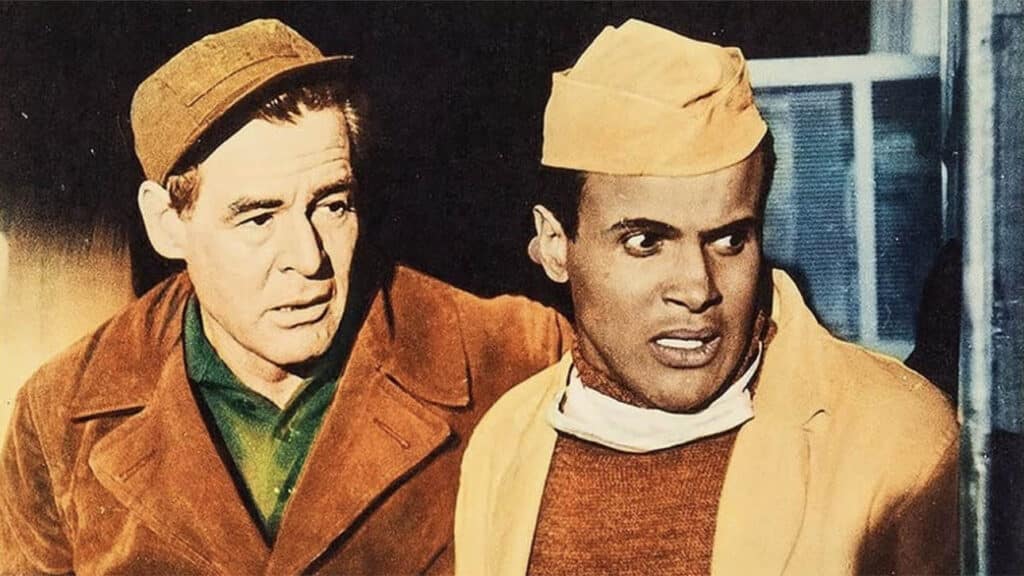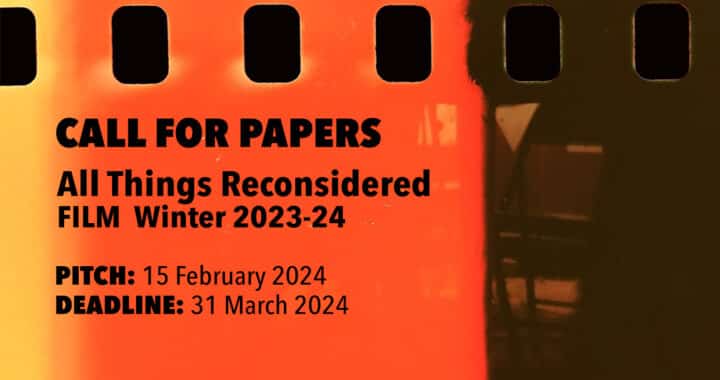
To all extents and purposes, film noir is a Hollywood genre that only existed for a limited number of years between the early ’40s and the late ’50s. Film noirs were made in considerable numbers, but some commentators have questioned whether this sizeable body of movies represents a bona fide film genre that stands in comparison to the Western. These commentators argue that a shared style or mood – rather than the presence of a set number of truly generic markers or character types – is what links film noir and, in turn, differentiates them from other film forms.
That argument may never be truly resolved, but we can accept two things for certain: 1. film noir continues to enthrall movie lovers – and influence moviemakers – 70 years on from the genre’s heyday in the ’40s; and 2. although it came late in the cycle, Robert Wise’s 1959 film, Odds Against Tomorrow can most definitely be categorised as a film noir.
Much of what we would expect to find in a film noir (whether classified as generic markers and character types or not) can be found in Wise’s film: the pointed use of chiaroscuro lighting in order to produce a variety of expressive shadows; crisp black and white cinematography, location shots of an impersonal big city, complete with lovingly framed puddles of reflective rainwater and steaming street grates; clever dialogue (of the hard-boiled tough guy variety); scenes set in transient spaces such as fun fairs, bars and hotel rooms; unusual camera angles; slick camera movements and a crime narrative that sees flawed and; desperate men being coerced and tempted into partaking in risk-laden and immoral behavior.
In common with a number of films from this period, Odds Against Tomorrow features dialogue and imagery that reference contemporaneous fears that the escalating cold war might end with a nuclear apocalypse. What distinguishes Odds Against Tomorrow from most other film noir is the presence of a strong black character and the film’s attendant comments on racism and race relations in contemporary America.
Dave Burke (Ed Begley) is an embittered ex-cop living in New York. His career was ruined when he was judged to be in contempt of court when he refused to talk during a corruption hearing. He didn’t get the pay-off that he expected from those his silence protected, and after years of brooding, he’s finally plotted the perfect crime.
He knows a quiet upstate bank that processes $200k in cash every Thursday evening. He also knows that an elderly guard routinely answers the bank’s side door around 6 pm to accept a coffee and sandwich delivery from the African-American waiter who works at the luncheon bar in a local drugstore. This 6 pm delivery is the bank’s obvious weak spot, but Burke needs two would-be rogues to help him implement his plans.
He selects an ex-military hothead and unemployable social misfit, Earle Slater (Robert Ryan), as his muscle. To take the place of the regular deliveryman (who will be suitably incapacitated), he selects a nightclub singer, Johnny Ingram (Harry Belafonte). Johnny has a severe gambling problem and he owes the local mob boss, Bacco (Will Kuluva), $7,500.
Both men initially turn Burke down. They’re not even petty thieves, let alone bank robbers, and they’re fearful of the severe consequences that getting caught will bring. In addition, Slater is a racist who refuses to work alongside a black man under any circumstances. However, Burke is a crafty operator who knows how to get what he wants, and his subsequent machinations result in both men reluctantly agreeing to assist him.
Film noirs were relatively cheap to produce. The fact that they were often made at the margins of the Hollywood studio system or by independent production companies meant that their directors could indulge in the kind of stylistic excesses that the big Hollywood studio bosses tended to frown upon. This production context also allowed the writers of film noirs to slip subversive narrative elements into their screenplays. Both observations ring true in the case of Odds Against Tomorrow, which was produced by Harry Belafonte’s own production company, HarBel.
Based on a novel by William P. McGivern, Belafonte asked Abraham Polonsky to co-write the film’s screenplay with Nelson Gidding. Following House Un-American Activities Committee investigations, Polonsky was blacklisted in Hollywood. So a “front name” by the African American writer John O. Killens was used in the film’s credits to conceal Polonsky’s involvement. Ultimately, Polonsky’s participation here confirms that Belafonte regarded Odds Against Tomorrow as a film with an important socio-political message.
After 1930, the representation of race – and, in particular, the representation of African Americans – in Hollywood films was prescriptively controlled by the tenets of the Hays Code. African American actors were given mainly small and highly stereotypical roles. But by the late ’50s, some liberal Hollywood filmmakers were beginning to produce films that reflected changes in public attitudes and, more importantly, directly addressed the concerns of the nascent Civil Rights movement.
The African American actor Sidney Poitier played an important role in bringing black characters of substance to the screen during the ’50s, but his characters tended to be unthreatening types: genial, virtuous, and distinctly asexual. Indeed, it’s generally accepted that Jim Brown was responsible for introducing more noticeably physical, rebellious, and sexual black male characters to Hollywood films during the ’60s.
But the roots of such characters clearly lay in Odds Against Tomorrow’s Johnny Ingram. Johnny’s sexual nature is flagged by the appearance of his pretty girlfriend, whom he subsequently canoodles with. He’s admittedly somewhat emasculated by the revelation that he’s been avoiding her of late, but, in his defense, he’s had more pressing matters to deal with.
It was still quite common in Hollywood films at this time for black characters to be coded in an infantilized way by virtue of the paternal actions and/or patronizing attitudes of the white characters they interacted with. Here the presence of Johnny’s young daughter (Lois Thorne) allows him to transcend this racial stereotype and act in a forthrightly paternal manner himself. When Earle tries to infantilize him with a patronizing and racist patter, Johnny refuses to stand for it. Indeed, the rebellious Johnny offers physical rebuffs to the white men that torment him.
Belafonte offers equal coverage of Johnny’s less-than-positive attributes. His reckless gambling has cost him his marriage, and he happily mixes with the disreputable types (both black and white) that frequent the nightclub where he sings. He also possesses a degree of racial and social class-based prejudice: he berates his ex-wife (Kim Hamilton) for hosting a parent-teacher association steering committee meeting that is led by middle-class white folk. Johnny might be desperate to be reunited with his family and to turn his life around, but becoming upwardly mobile and fully integrated into mainstream white society doesn’t directly appeal to him.
Also struggling to find his way in the big city is the racist Southerner Earle Slater. His temper has gotten him into big trouble, which means he’s now unemployable. He’s starting to feel his age, but Earle also experiences feelings of emasculation due to the fact that he’s living off of the earnings of his much younger girlfriend, Lorry (Shelley Winters).
To add insult to injury, he’s been reduced to running menial household errands while she’s out at work. His biggest fear is that Lorry will leave him, but when he’s angry and under pressure, Earle becomes as reckless as Johnny: he cracks and responds to and sleeps with a feckless and flirtatious neighbor (Gloria Grahame) even though he despises her.
As such, Earle, Johnny, and Dave Burke are all archetypal film noir characters. They’ve been left crushed and isolated by the fast pace and impersonal nature of modernity, capitalism, and the big city. We guess at the start of the film that the trio’s desperate efforts to get ahead in life by nefarious means cannot completely succeed because the Hays Code would not have allowed such a narrative to be filmed.
Consequently, the film becomes imbued with a palpable sense of dread and foreboding just as soon as Earle and Johnny sign up with Burke. But what could possibly go wrong with this seemingly foolproof heist? With this question firmly planted in the viewer’s mind, Wise, his crew, and his actors work with supreme proficiency in order to generate a wholly effective and tangible sense of suspense that makes the build-up to – and the execution of – the bank job absolutely gripping viewing.
Odds Against Tomorrow impresses at every technical level, but its actors’ performances are particularly good. It goes without saying that great acting is to be expected from Oscar nominees such as Robert Ryan and Oscar winners such as Shelley Winters, Ed Begley, and Gloria Grahame.
But Harry Belafonte (who was still best known as a singer then) also provides a pleasing and convincing performance. There’s lots of good work from the supporting cast, too. Odds Against Tomorrow is also aided and distinguished by the intense and expressive jazz score that was provided by John Lewis and the Modern Jazz Quartet.
Director Robert Wise made many well-regarded films in various genres, but he was particularly adept at making film noirs. In addition to the staple noir elements listed at the start of this review, Odds Against Tomorrow also features perfect executions of typically noir stylistic effects such as shots that incorporate reflections in mirrors, canted shots, and shots filmed from noticeably odd or disorientating angles, sets that are sometimes expressionistic in nature and expertly deployed deep focus cinematography.


![Call for Papers: All Things Reconsidered [MUSIC] May-August 2024](https://www.popmatters.com/wp-content/uploads/2024/04/all-things-reconsidered-call-music-may-2024-720x380.jpg)



